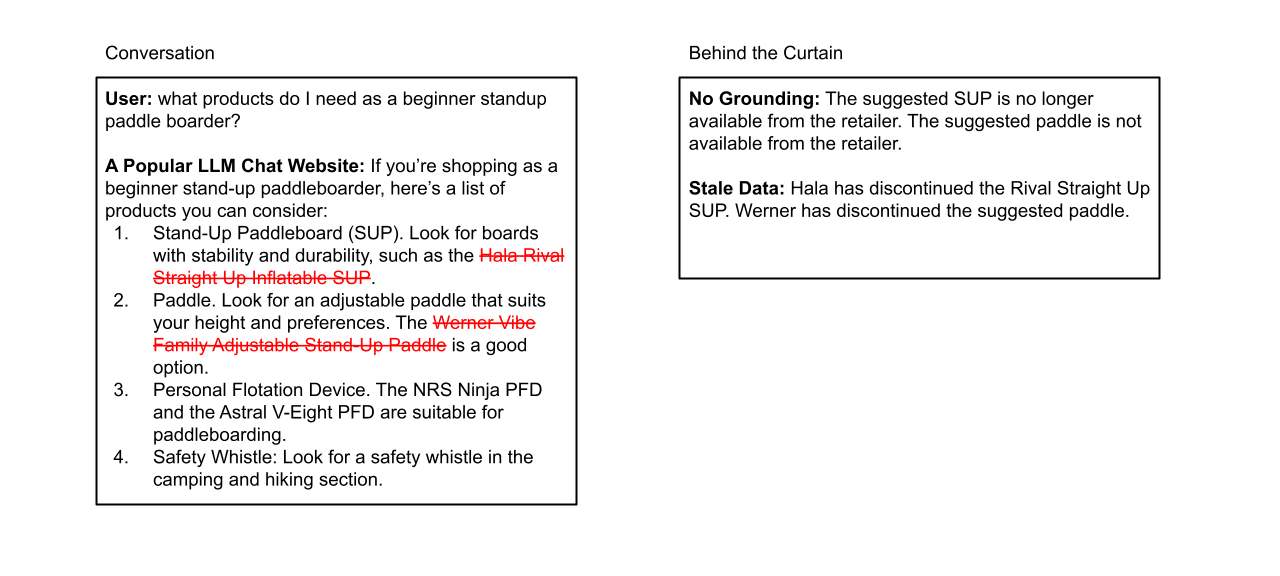Why Conversational Search Is the Next Leap in Ecommerce
We look at what conversational search is, how it relates to large language models like ChatGPT and PaLM 2, and how the technology can provide engaging search experiences.

The product and knowledge discovery industry has made significant strides in integrating natural language features into the search experience over the years. While there is always room for improvement, Lucidworks is thrilled with the progress we have made. We do still see that most ecommerce users enter queries of three or fewer words, perhaps guessing at how the search engine works, or giving up and moving over to the browse experience.
By training users to learn to search using metadata terms (for example, “women’s sneakers white”) rather than natural language (women’s white sneakers suitable for the office), we actually encourage ambiguity in query strings. The user wastes time and the search platform misses out on a more explicit expression of what the user is trying to accomplish.
Another aspect of today’s search experience is that the platform must depend on implicit signals in order to predict the user’s general goal. Is this browse related to the same goal as the previous search? Is the user research mode or ready to purchase? It is difficult to predict the user’s transition from one goal (new threads for the office) to another (a gift for my mom).
Enter conversational search
We, at Lucidworks, believe that generative large language models enable us to accelerate progress towards a more conversational search experience – an experience that encourages users to express their goals in natural language. We intend to enable the search platform to behave as an assistant that guides the user by asking relevant questions and making suggestions rather than being limited to finding things based on what’s in the search box, and guessing at goals based on implicit signals.
An example: Let’s say I want to replace the thin shelves that came with a garage storage rack that I purchased ten years ago because they are sagging. When I go to a home improvement store and find a knowledgeable employee, I’m inclined to begin a conversation by describing my task.
“What kind of plywood should I use to replace the sagging shelves in my garage storage rack?” The employee will likely ask me questions about the dimensions of the shelves, what I will store on the shelves, if the garage is damp, etc. We end up having a short conversation, and I leave with probably more items than a sheet of plywood.
If instead I had decided to shop online, I would start by thinking through how to interact with the website. Let’s see, I don’t know what kind of plywood I need – I’ll start by browsing. Hopefully I’ll find good product use descriptions, or helpful reviews by other shoppers who have tackled a similar project.
This person-to-person approach is effective but not very scalable. Generative large language models will enable us to move the online search experience closer to the efficient exchange of information that comes from a person-to-person conversation.
Strategizing conversational search experiences
Okay, let’s talk about how we get there.
We start by considering elements of a good conversation. There are hundreds of lists of “the elements of a good conversation” – here are four I find to be relevant to the idea of conversational search:
#1. Listen actively. Active listening isn’t just repeating the question. It’s about asking clarifying questions and offering suggestions. And it’s about remembering the context of the conversation so the other party doesn’t have to repeat the same information.
#2. Pay attention to non-verbal cues. A search platform can’t see our body language, but it can pay attention to implicit signals. Conversational search delivers a new source of explicit signals, but we still need to pay attention to implicit signals.
#3. Stay on topic. Questions and responses should be relevant to the current conversation. This includes recommendations and other types of personalization.
#4. Build trust. Participants in a conversation build trust by being consistent, truthful, respectful, and willing to admit mistakes.
Our strategy is based on the idea that a generative language model can be instruction-tuned and prompted to perform a task related to an aspect of conversational search, while maintaining the elements of good conversation. We are creating a set of language model-powered agents to perform specific tasks, each of them with access to shared memory of conversations and associated implicit signals. We have built an ML Platform for surfacing conversational search features.
Our strategy can be visualized as such:

Query Understanding: We will use a generative language model to improve query understanding in order to improve the performance of hybrid search. What specifications are present in the query? Should the query be rewritten to improve recall or relevance ranking? We will also use a generative language model to improve the training of the semantic encoder model used by hybrid search, by generating additional synthetic training data. Pay attention to non-verbal queues. Stay on topic.
Hybrid Search: The system uses hybrid search (semantic + lexical) to cast a wide enough net so that there is a high probability of most relevant documents (I’m going to use “document” to represent a description of a thing – a product, a research paper, a customer service FAQ) being retrieved. The hybrid search is dependent on the semantic model – an encoder language model that represents a semantic vector space – to handle the recall and initial relevance ranking. Hybrid search must adhere to established access control to content, sometimes referred to as security trimming. Build trust. Stay on topic.
Retrieval Augmented Generation: A generative language model reranks and describes the results from hybrid search using natural language. This is an implementation of Retrieval Augmented Generation, where the output of the generative model is limited to the documents recalled by the preceding hybrid search. Some describe this as “grounding”. RAG is a key component of grounding generative language model responses in fact, and allows us to cite references. Build trust. Stay on topic.
Reflection: The generative language model reflects on its output from the previous step. Its task is to determine (by prompting itself!) if it can produce a better response. This step also incorporates a memory feature, so that it can benefit from prior reflections. Build trust. Stay on topic.
Conversation Monitor: We use a generative language model, working outside of the conversation context, to monitor both user and other model responses for respectful content. Some describe this as “alignment.” Build Trust.
Descriptions: We use additional prompts to request the generative language model to describe the individual documents in the results list. What is the most pertinent part of this document given the search conversation so far? What are the unique features of this product given the conversation so far? Listen Actively.
Conversational Responses: The idea is that an implementation of conversational search should allow the user to ask questions and give additional instructions to continue a conversation after their initial request. And the search platform should respond to those inputs by asking clarifying questions to help refine its understanding of the user’s goal. Listen actively. Build trust.
Implicit Signals Prompting: Let’s assume that, so far, the user has not entered another prompt – they haven’t continued the explicit conversation. However, they have interacted with the system by clicking on results, filtering results, etc. We can incorporate these implicit signals into some behind-the-curtain prompting of our generative language model. Pay attention to non-verbal cues.
RLHF Instruction Tuning: RLHF is reinforcement learning from human feedback. The idea is to continuously update fine-tuning instructions based on the explicit conversations and associated implicit signals. Listen actively. Pay attention to non-verbal queues.
An Illustration
First, let’s have a look at what can happen today when a user asks a general purpose chat website powered by an LLM to recommend products.

Now, assume that we’ve used a conversational search platform to deploy an ecommerce application specific to one retailer’s product catalog. This application will rely on several data sources available from the retailer, including the product catalog, how-to articles, etc.

Next Steps
At Lucidworks, we’re already thinking about where we’d like to take the potential of conversational search in a way that makes sense for our product and customers. We’ll be beginning with several implementations, such as:
- Query keyword extraction
- Hybrid search and RAG
- Document summaries
- Improved training of semantic models
- Allowing users to select the conversation they wish to continue.
We’ll be rolling out these features in Beta this coming June. Learn more about our thoughts on the relationship between LLMs like ChatGPT and our Fusion platform, or take a look at our generative AI field guide for more on our approach to the technology. If you’d like to learn more about how Lucidworks solutions can support your brand’s search strategy, contact us today.
LEARN MORE
Contact us today to learn how Lucidworks can help your team create powerful search and discovery applications for your customers and employees.